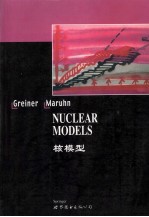

Nuclear modelsPDF电子书下载
- 电子书积分:13 积分如何计算积分?
- 作 者:WalterGreiner,JoachimA.Maruhn著
- 出 版 社:世界图书出版公司北京公司
- 出版年份:2004
- ISBN:7506265869
- 页数:378 页
1.Introduction 1
1.1 Nuclear Structure Physics 1
1.2 The Basic Equation 2
1.3 Microscopic versus Collective Models 3
1.4 The Role of Symmetries 5
2.Symmetries 7
2.1 General Remarks 7
2.2 Translation 8
2.2.1 The Operator for Translation 8
2.2.2 Translational Invariance 9
2.2.3 Many-Particle Systems 10
2.3 Rotation 11
2.3.1 The Angular Momentum Operators 11
2.3.2 Representations of the Rotation Group 16
2.3.3 The Rotation Matrices 20
2.3.4 SU(2)and Spin 21
2.3.5 Coupling of Angular Momenta 25
2.3.6 Intrinsic Angular Momentum 27
2.3.7 Tensor Operators 30
2.3.8 The Wigner-Eckart Theorem 35
2.3.9 6j and 9j Symbols 37
2.4 Isospin 39
2.5 Parity 42
2.5.1 Definition 42
2.5.2 Vector Fields 42
2.6 Time Reversal 43
3.Second Quantization 47
3.1 General Formalism 47
3.1.1 Motivation 47
3.1.2 Second Quantization for Bosons 50
3.1.3 Second Quantization for Fermions 52
3.2 Representation of Operators 53
3.2.1 One-Particle Operators 53
3.2.2 Two-Particle Operators 56
3.3 Evaluation of Matrix Elements for Fermions 58
3.4 The Particle-Hole Picture 60
4.Group Theory in Nuclear Physics 65
4.1 Lie Groups and Lie Algebras 65
4.2 Group Chains 72
4.3 Lie Algebras in Second Quantization 73
5.Electromagnetic Moments and Transitions 75
5.1 Introduction 75
5.2 The Quantized Electromagnetic Field 75
5.3 Radiation Fields of Good Angular Momentum 77
5.3.1 Solutions of the Scalar Helmholtz Equation 77
5.3.2 Solutions of the Vector Helmholtz Equation 78
5.3.3 Properties of the Multipole Fields 81
5.3.4 Multipole Expansion of Plane Waves 82
5.4 Coupling of Radiation and Matter 85
5.4.1 Basic Matrix Elements 85
5.4.2 Multipole Expansion of the Matrix Elements and Selection Rules 88
5.4.3 Siegert's Theorem 90
5.4.4 Matrix Elements for Emission in the Long-Wavelength Limit 91
5.4.5 Relative Importance of Transitions and Weisskopf Estimates 95
5.4.6 Electric Multipole Moments 97
5.4.7 Effective Charges 97
6.Collective Models 99
6.1 Nuclear Matter 99
6.1.1 Mass Formulas 99
6.1.2 The Fermi-Gas Model 101
6.1.3 Density-Functional Models 103
6.2 Nuclear Surface Deformations 106
6.2.1 General Parametrization 106
6.2.2 Types of Multipole Deformations 108
6.2.3 Quadrupole Deformations 110
6.2.4 Symmetries in Collective Space 115
6.3 Surface Vibrations 117
6.3.1 Vibrations of a Classical Liquid Drop 117
6.3.2 The Harmonic Quadrupole Oscillator 124
6.3.3 The Collective Angular-Momentum Operator 128
6.3.4 The Collective Quadrupole Operator 130
6.3.5 The Quadrupole Vibrational Spectrum 132
6.4 Rotating Nuclei 138
6.4.1 The Rigid Rotor 138
6.4.2 The Symmetric Rotor 143
6.4.3 The Asymmetric Rotor 145
6.5 The Rotation-Vibration Model 147
6.5.1 Classical Energy 147
6.5.2 Quantal Hamiltonian 151
6.5.3 Spectrum and Eigenfunctions 155
6.5.4 Moments and Transition Probabilities 159
6.6 γ-Unstable Nuclei 168
6.7 More General Collective Models for Surface Vibrations 170
6.7.1 The Generalized Collective Model 170
6.7.2 Proton-Neutron Vibrations 177
6.7.3 Higher Multipoles 177
6.8 The Interacting Boson Model 178
6.8.1 Introduction 178
6.8.2 The Hamiltonian 180
6.8.3 Group Chains 182
6.8.4 The Casimir Operators 184
6.8.5 The Dynamical Symmetries 187
6.8.6 Transition Operators 192
6.8.7 Extended Versions of the IBA 193
6.8.8 Comparison to the Geometric Model 196
6.9 Giant Resonances 197
6.9.1 Introduction 197
6.9.2 The Goldhaber-Teller Model 200
6.9.3 The Steinwedel-Jensen Model 202
6.9.4 Applications 205
7.Microscopic Models 207
7.1 The Nucleon-Nucleon Interaction 207
7.1.1 General Properties 207
7.1.2 Functional Form 210
7.1.3 Interactions from Nucleon-Nucleon Scattering 211
7.1.4 Effective Interactions 214
7.2 The Hartree-Fock Approximation 217
7.2.1 Introduction 217
7.2.2 The Variational Principle 218
7.2.3 The Slater-Determinant Approximation 219
7.2.4 The Hartree-Fock Equations 220
7.2.5 Applications 225
7.2.6 The Density Matrix Formulation 227
7.2.7 Constrained Hartree-Fock 229
7.2.8 Alternative Formulations and Three-Body Forces 230
7.2.9 Hartree-Fock with Skyrme Forces 231
7.3 Phenomenological Single-Particle Models 237
7.3.1 The Spherical-Shell Model 237
7.3.2 The Deformed-Shell Model 248
7.4 The Relativistic Mean-Field Model 261
7.4.1 Introduction 261
7.4.2 Formulation of the Model 261
7.4.3 Applications 266
7.5 Pairing 269
7.5.1 Motivation 269
7.5.2 The Seniority Model 272
7.5.3 The Quasispin Model 278
7.5.4 The BCS Model 280
7.5.5 The Bogolyubov Transformation 285
7.5.6 Generalized Density Matrices 290
8.Interplay of Collective and Single-Particle Motion 293
8.1 The Core-plus-Particle Models 293
8.1.1 Basic Considerations 293
8.1.2 The Weak-Coupling Limit 294
8.1.3 The Strong-Coupling Approximation 296
8.1.4 The Interacting Boson-Fermion Model 302
8.2 Collective Vibrations in Microscopic Models 303
8.2.1 The Tamm-Dancoff Approximation 303
8.2.2 The Random-Phase Approximation(RPA) 309
8.2.3 Time-Dependent Hartree-Fock and Linear Response 312
9.Large-Amplitude Collective Motion 317
9.1 Introduction 317
9.2 The Macroscopic-Microscopic Method 318
9.2.1 The Liquid-Drop Model 318
9.2.2 The Shell-Correction Method 320
9.2.3 Two-Center Shell Models 324
9.2.4 Fission in Self-Consistent Models 335
9.3 Mass Parameters and the Cranking Model 337
9.3.1 Overview 337
9.3.2 The Irrotational-Flow Model 337
9.3.3 The Cranking Formula 338
9.3.4 Applications of the Cranking Formula 340
9.4 Time-Dependent Hartree-Fock 344
9.5 The Generator-Coordinate Method 346
9.6 High-Spin States 353
9.6.1 Overview 353
9.6.2 The Cranked Nilsson Model 355
Appendix:Some Formulas from Angular-Momentum Theory 359
References 363
Subject Index 369
- 《TED说话的力量 世界优秀演讲者的口才秘诀》(坦桑)阿卡什·P.卡里亚著 2019
- 《小手画出大世界 恐龙世界》登亚编绘 2008
- 《近代世界史文献丛编 19》王强主编 2017
- 《课堂上听不到的历史传奇 世界政治军事名人 初中版》顾跃忠等编著 2015
- 《指向核心素养 北京十一学校名师教学设计 英语 七年级 上 配人教版》周志英总主编 2019
- 《365奇趣英语乐园 世界民间故事》爱思得图书国际企业 2018
- 《近代世界史文献丛编 36》王强主编 2017
- 《北京生态环境保护》《北京环境保护丛书》编委会编著 2018
- 《近代世界史文献丛编 11》王强主编 2017
- 《近代世界史文献丛编 18》王强主编 2017
